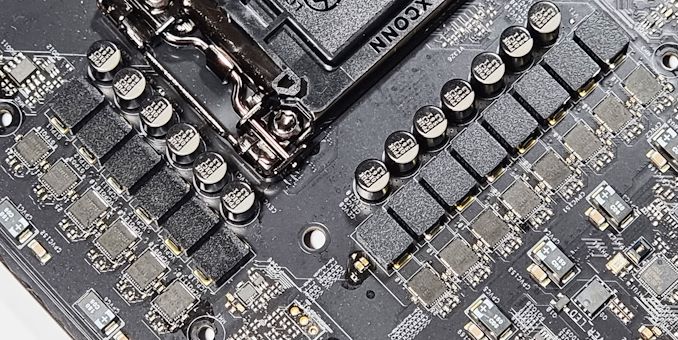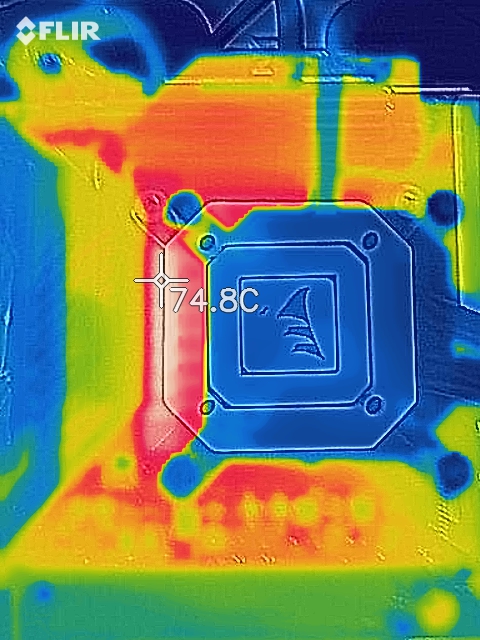ASRock Z590 Taichi Review: An Intel Motherboard with Moving Parts (and Thunderbolt 4)
by Gavin Bonshor on April 1, 2021 11:00 AM ESTPower Delivery Thermal Analysis
A lot more focus has been put onto power delivery specifications and capabilities, not just by manufacturers, but as a result of users demands. In addition to the extra power benefits from things like overclocking, more efficient designs in power deliveries and cooling solutions aim to bring temperatures down. Although this isn't something most users ever need to worry about, certain enthusiasts are bringing more focus onto each boards power delivery. The more premium models tend to include bigger and higher-grade power deliveries, with bigger and more intricate heatsink designs, with some even providing water blocks on ranges such as the ASUS ROG Maximus Formula series, and the ASRock Aqua.

The 14-phase power delivery on the ASRock Z590 Taichi (operating in 6+2)
Testing Methodology
Our method of testing out if the power delivery and its heatsink are effective at dissipating heat, is by running an intensely heavy CPU workload for a prolonged method of time. We apply an overclock which is deemed safe and at the maximum that the silicon on our testbed processor allows. We then run the Prime95 with AVX2 enabled under a torture test for an hour at the maximum stable overclock we can which puts insane pressure on the processor. We collect our data via three different methods which include the following:
- Taking a thermal image from a birds-eye view after an hour with a Flir Pro thermal imaging camera
- Securing two probes on to the rear of the PCB, right underneath CPU VCore section of the power delivery for better parity in case a probe reports a faulty reading
- Taking a reading of the VRM temperature from the sensor reading within the HWInfo monitoring application
The reason for using three different methods is that some sensors can read inaccurate temperatures, which can give very erratic results for users looking to gauge whether an overclock is too much pressure for the power delivery handle. With using a probe on the rear, it can also show the efficiency of the power stages and heatsinks as a wide margin between the probe and sensor temperature can show that the heatsink is dissipating heat and that the design is working, or that the internal sensor is massively wrong. To ensure our probe was accurate before testing, I binned 10 and selected the most accurate (within 1c of the actual temperature) for better parity in our testing.
To recreate a real-world testing scenario, the system is built into a conventional desktop chassis which is widely available. This is to show and alleviate issues when testing on open testbeds which we have done previously, which allows natural airflow to flow over the power delivery heatsinks. It provides a better comparison for the end-user and allows us to mitigate issues where heatsinks have been designed with airflow in mind, and those that have not. The idea of a heatsink is to allow effective dissipation of heat and not act as an insulator, with much more focus from consumers over the last couple of years on power delivery componentry and performance than in previous years.
For thermal image, we use a Flir One camera as it gives a good indication of where the heat is generated around the socket area, as some designs use different configurations and an evenly spread power delivery with good components will usually generate less heat. Manufacturers who use inefficient heatsinks and cheap out on power delivery components should run hotter than those who have invested. Of course, a $700 flagship motherboard is likely to outperform a cheaper $100 model under the same testing conditions, but it is still worth testing to see which vendors are doing things correctly.
Thermal Analysis Results

We measured 74.8ºC on the hottest part of the CPU socket during our testing
The ASRock Z590 Taichi is using a 14-phase power delivery which is operating in 6+2 mode. The CPU section includes twelve Renesas ISL99390 90 A smart power stages, which are doubled up with six ISL6617A doublers. For the SoC section, ASRock is using two ISL99390 90 A smart power stages which are operating independently. Controlling the power delivery is a Renesas ISL69269 PWM controller, which combined with the 12-phase for the CPU operating at 6/6, can deliver a whopping maximum of 1080 A to the processor. The power delivery is cooled by an active design, which includes dual heatsinks which are interconnected by a single heat-pipe. ASRock includes a secondary 3 cm cooling fan and brackets to enhance the thermal capabilities of the VRM, but we have opted not to use this for our VRM thermal testing.
*We believe the ASRock Z590 Steel Legend WIFI 6E has a faulty VRM sensor which topped out at 66ºC
We're still making our way through our review stack, which we will update when we add more boards in the coming week. Looking at our current set of thermal VRM results for the Z590 Taichi, our results show the power delivery to run warm, but still well within the power deliveries' official specification, with a readout of 68ºC from the board's integrated sensor. As this is an active cooling solution due to a fan integrated into the rear panel cover and sitting just above the heatsink on the CPU section, it's currently hard to gauge the overall thermal efficiency of ASRock's cooling method.
Comparing it directly to the GIGABYTE Z590 Aorus Master which is passively cooled, we can see that the Taichi thermals are 10ºC cooler overall, which shows the power stages are being cooled effectively. As the area around the CPU socket is hotter than the actual power delivery, a lot of this can be put down to the heat of the processor which hovered around 100ºC+.











50 Comments
View All Comments
Cullinaire - Thursday, April 1, 2021 - link
What a gimmick. Instead of a stepper motor why not have a steam engine powered by the CPU heat.Molor1880 - Thursday, April 1, 2021 - link
Should have gone with a tiny sterling engine. That would make this joke a bit better.kachan64 - Friday, April 2, 2021 - link
Agree. Should have gone with that!YB1064 - Friday, April 2, 2021 - link
No 10GbE on a FOUR HUNDRED dollar motherboard?? No thanks.zanon - Saturday, April 3, 2021 - link
This, the money they put into the gimmick useless juno should have gone to networking instead. Though I suppose in fairness unlike AMD they have to work with severe bandwidth limitations so they can't just do every single useful feature. But that one should have been a priority.ZoZo - Saturday, April 3, 2021 - link
There's the same bandwidth on the Z590 platform as the X570.20 PCI-E 4.0 lanes from the CPU, and ~4 GB/s between CPU and chipset (through 4 PCI-E 4.0 lanes on X570, and 8 DMI/PCI-E 3.0 lanes on Z590).
And 10 Gb/s networking just needs 1.25 GB/s, so no severe bandwidth limitations from connecting it to a PCI-E 3.0 x1 link to the chipset.
TheinsanegamerN - Sunday, April 4, 2021 - link
The raichu line had 10gb as a selling point with the z200 and x400 vhipsets. For some reason asrock abandoned this idea and raised the price.TheinsanegamerN - Sunday, April 4, 2021 - link
Agreed. The whole reason to get a taichi was the 10gb ethernet onboard.Samus - Saturday, April 3, 2021 - link
This is about the level of gimmick I expected from ASRock, after all the brand is a second-rate Asus so they need to do these cheesy things to get attention.zotric - Sunday, October 10, 2021 - link
I must say I have had excellent support for my older ASRock Taichi board so don't write it off!